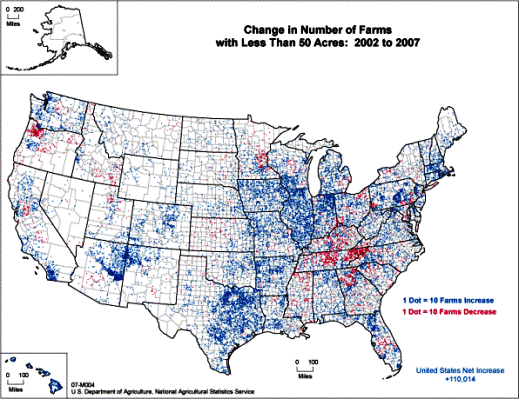Trends in the Growth of Small Farms – And Hope for the Future
Most farms in the United States are now small, with almost 40% of U.S. farms now less than 50 Acres, and 60 percent of all farms reporting less than $10,000 in total sales of agricultural products. New farms, in particular tend to be small. While USDA-NASS Ag. Census data shows a net increase of 75,810 new farms between 2002 and 2007, they disproportionately fall within the lowest size categories (2007 Ag Census). The following data shows the change in the number of farms by size category between 2002 and 2007:
1-9 Acres: +53503
10-49 Acres: +56511
50-179 Acres: +1825
180-499 Acres: -20249
500-999 Acres: -11839
1000-1999 Acres: -6362
2000+ Acres: +2423
This is not necessarily all bad. Despite the fact that most small farms don’t generate significant income, there are many that do. And I work with a number of new small farmers who make a living on farms under 50 acres in size. Still, of the 2.2 million principle farm operators nationwide, only 1 million show positive net cash income from their agricultural operations, with the remaining 1.2 million farms depending on non-farm income to cover farm expenses. In addition, the total share of farmers working off-farm grew from 55 percent in 2002 to 65 percent in 2007. And this trend is clearly unsustainable.
Interestingly, the change in farm size is also geographically dependent, with certain areas showing significant growth in the number of farms smaller than 50 acres, and others showing a decline. The following map illustrates these geographical differences:
Former Secretary of Agriculture Earl Butz was famous for telling farmers to “get big, or get out”. But based on my research with small growers who are supporting their families farming full time, I take a more nuanced view which might be summed up as “be small, but be smart”.
Important trends such as a significant increase in both the number and variety of local direct marketing opportunities which can both increase the farmer’s share of food dollars, and decrease transportation and storage costs; the growing demand for organic products and the price premiums often associated with them; the increasing popularity of high value specialty crops and value added products; and the adoption of techniques such as season extension using passive solar hoop-houses, have allowed many farmers to generate greater revenue on smaller acreages.
Clearly these developments have not been sufficient to offset the disturbing trends cited earlier, but I remain cautiously optimistic. As energy costs soar, the economic benefits of growing food closer to where it is sold will undoubtedly increase, and innovative, creative, diversified small farmers will continue to expand their ability to generate more value from their small acreages. It seems plausible then, that small farms may become increasingly viable. Is it possible that these factors will begin to ameliorate the more disturbing trends that have been associated with the increase in small farms, or even reverse them?
It is certainly too soon to know. But while many observers seem only to present pessimistic forecasts, I am am willing to pin my hopes on the ingenuity, determination, and resilience of the growing number of small, young, beginning, and sustainable farmers who seem to be bucking the trends and beating the odds. And I will continue to to eat to their health.
– Taylor Reid







 Your Privacy Choices
Your Privacy Choices
Leave a comment